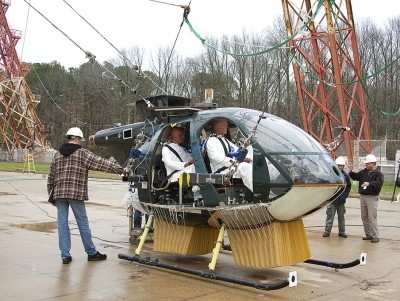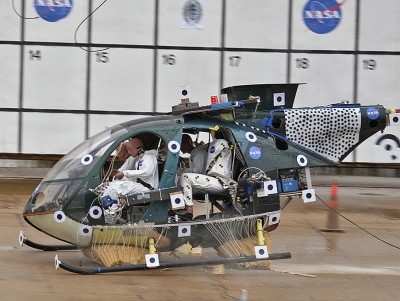Airbag-Like-System Protects Helicopter In Drop Test
 If you saw the video, you might
think you were watching an episode of "Mythbusters" rather than a
NASA experiment. A system designed by NASA to cushion
spacecraft during hard landings was recently tested on a helicopter
airframe to see if it would protect the occupants in the event of a
crash.
If you saw the video, you might
think you were watching an episode of "Mythbusters" rather than a
NASA experiment. A system designed by NASA to cushion
spacecraft during hard landings was recently tested on a helicopter
airframe to see if it would protect the occupants in the event of a
crash.
For the test, a "deployable energy absorber", a honeycomb
cushion made of kevlar, was attached to an MD-500 fuselage donated
by the Army. The fuselage, with crash test dummies sitting in the
seats, was dropped from about 35 feet to simulate a helicopter
crash. On impact, the helicopter's skid landing gear bent outward,
but the cushion attached to its belly kept the rotorcraft's bottom
from touching the ground. Four crash test dummies along for the
ride appeared only a little worse for the wear.
Researchers must analyze the test results before they can say
for sure whether the deployable energy absorber worked as
designed.
"I'd like to think the research we're doing is going to end up
in airframes and will potentially save lives," said Karen Jackson,
an aerospace engineer who oversaw the test at NASA's Langley
Research Center in Hampton, VA.

Photo Credit NASA
According to the National Transportation Safety Board, more than
200 people are injured in helicopter accidents in the United States
each year, in part because helicopters fly in riskier conditions
than most other aircraft. They fly close to the ground, not far
from power lines and other obstacles, and often are used for
emergencies, including search and rescue and medical
evacuations.
For the test at Langley, researchers used an MD-500 helicopter
donated by the U.S. Army. The rotorcraft was equipped with
instruments that collected 160 channels of data. One of the four
crash test dummies was a special torso model equipped with
simulated internal organs. It came from the Johns Hopkins
University Applied Physics Laboratory in Laurel, MD.
Technicians outfitted the underside of the helicopter's crew and
passenger compartment with the deployable energy absorber. Created
by engineer Sotiris Kellas at Langley, the device has a unique
flexible hinge design that allows the honeycomb to be packaged and
remain flat until needed.
Jackson said researchers tested the deployable energy absorber
under realistic conditions. "We crash-tested the helicopter by
suspending it about 35 feet (10.7 m) into the air using cables.
Then, as it swung to the ground, we used pyrotechnics to remove the
cables just before the helicopter hit so that it reacted like it
would in a real accident," she explained.

Photo Credit NASA
The test conditions imitated what would be a relatively severe
helicopter crash. The flight path angle was about 33 degrees and
the combined forward and vertical speeds were about 48 feet per
second or 33 miles per hour.
"We got data to validate our integrated computer models that
predict how all parts of the helicopter and the occupants react in
a crash. Plus the torso model test dummy will help us assess
internal injuries to occupants during a helicopter crash."
Engineers say the MD-500 survived relatively intact as a result
of the honeycomb cushion. They plan to recycle the helicopter and
drop it again next year, but without the deployable energy absorber
attached, in order to compare the results.
 NTSB Final Report: Rutan Long-EZ
NTSB Final Report: Rutan Long-EZ ANN FAQ: Turn On Post Notifications
ANN FAQ: Turn On Post Notifications Classic Aero-TV: ICAS Perspectives - Advice for New Air Show Performers
Classic Aero-TV: ICAS Perspectives - Advice for New Air Show Performers ANN's Daily Aero-Linx (06.28.25)
ANN's Daily Aero-Linx (06.28.25) Aero-News: Quote of the Day (06.28.25)
Aero-News: Quote of the Day (06.28.25)





